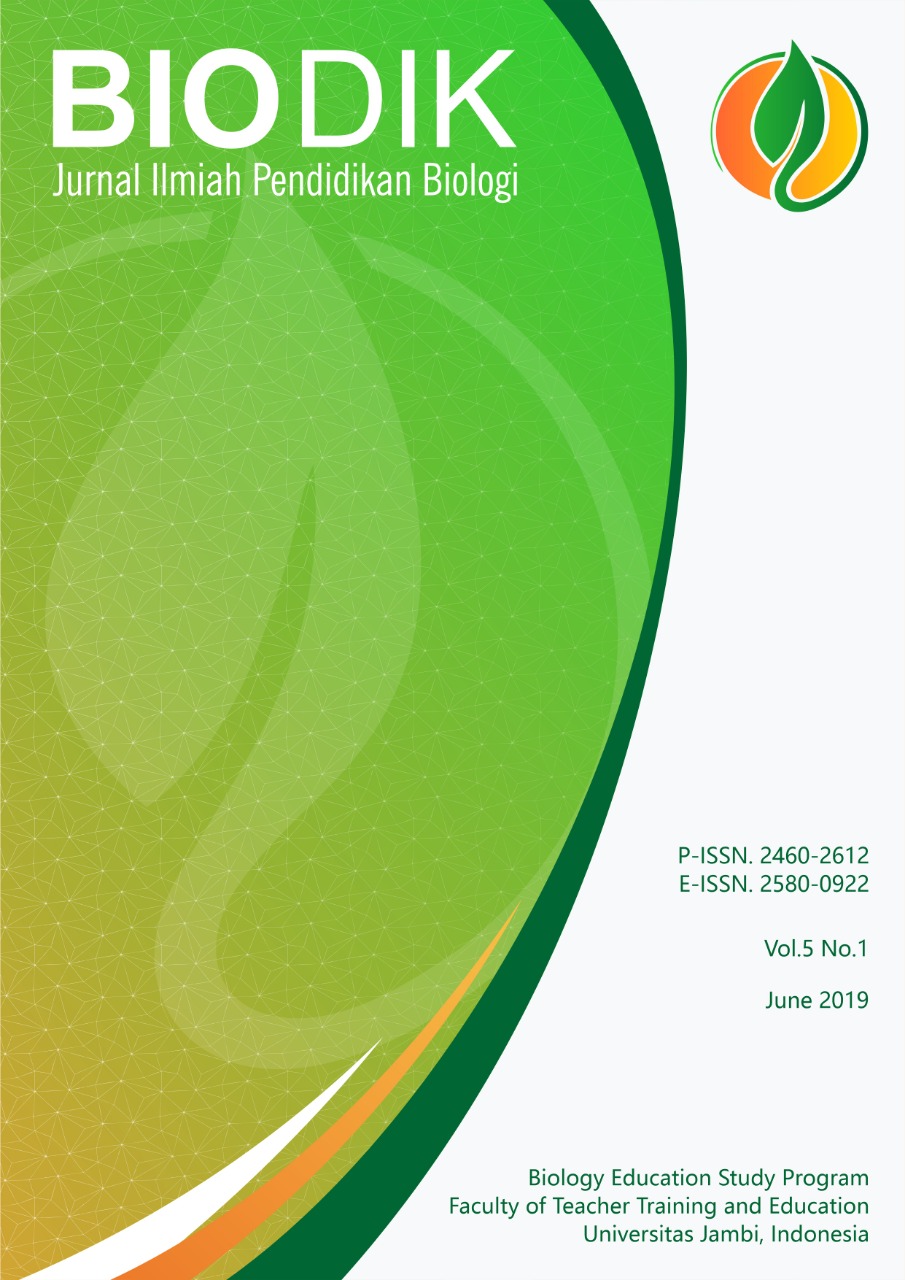Penerapan Pembelajaran Kooperatif Tipe Numbered Heads Together (NHT) Berbantuan Aplikasi Moodle untuk Meningkatkan Hasil Belajar Kognitif Peserta Didik di SMA Negeri Titian Teras Jambi
DOI:
https://doi.org/10.22437/bio.v5i1.6393Abstract
The ability of students to understand the biological material conveyed by the teacher is certainly different from each other, therefore we need the right learning model and media to be used in the learning process. The discussion method commonly used by teachers has not been able to improve learning outcomes to the fullest. This is evidenced by the low participation of students in group discussions. Discussion is dominated by only certain students. This affects the cognitive learning outcomes of participants, it can be seen that the results of the correct answers to the questions about Genetic Material at the first try out of UN and USBN in 2018 were 40.28%, the second try out was 64.18% and USBN 2018 was 40.12%. still far below the KKM for 3.3 KD, which is 75. One solution that can be done immediately is through PTK, by implementing NHT type cooperative learning assisted by the Moodle application to improve cognitif learning achievement of students. The research instrument used was a test with multiple choice questions in two cycles. The results of the first cycle test showed an increase in classical completeness from the pre-action results which was 20.83%, increasing to 70.83%. In cycle 2 classical completeness increased to 78.26% and has reached the limit specified in the Action Success Index of 75%.
Keywords: Learning Achievement, aplikasi Moodle, Numbered Heads Together (NHT).
Abstrak. Kemampuan peserta didik dalam memahami materi biologi yang disampaikan oleh guru tentu berbeda satu sama lain, oleh karena itu dibutuhkan model dan media pembelajaran yang tepat untuk digunakan dalam proses pembelajaran. Metode diskusi yang biasa digunakan guru belum mampu meningkatkan hasil belajar secara maksimal. Hal ini dibuktikan dengan rendahnya partisipasi peserta didik dalam melakukan diskusi kelompok. Diskusi didominasi oleh peserta didik tertentu saja. Hal ini berimbas kepada hasil belajar kognitif peserta,terlihat bahwa hasil jawaban benar pada soal tentang Materi Genetik pada try out pertama UN dan USBN tahun 2018 sebesar 40,28%, try out kedua sebesar 64,18% dan USBN 2018 sebesar 40,12% masih jauh dibawah KKM untuk KD 3.3 yakni 75. Salah satu solusi yang dapat dilakukan segera adalah melalui PTK, dengan menerapkan pembelajaran kooperatif tipe NHT berbantuan aplikasi Moodle untuk meningkat hasil belajar kognitif peserta didik. Instrumen penelitian yang digunakan adalah tes dengan bentuk soal pilihan ganda, dilakukan dalam 2 siklus. Hasil tes siklus 1 menunjukkan adanya peningkatan ketuntasan klasikal dari hasil pratindakan yakni 20,83% meningkat menjadi 70,83%. Pada siklus 2 ketuntasan klasikal meningkat menjadi 78,26% dan telah mencapai batas yang ditentukan dalam Indeks Keberhasilan Tindakan yakni 75%.
Kata Kunci: Hasil Belajar, aplikasi Moodle, Numbered Heads Together (NHT).
Downloads
Downloads
Published
Versions
- 2019-06-24 (1)
- 2019-06-24 (1)
How to Cite
Issue
Section
License
Copyright Notice
Authors who publish with Biodik : Jurnal Ilmiah Pendidikan Biologi agree to the following terms:
- For all articles published in Biodik : Jurnal Ilmiah Pendidikan Biologi, copyright is retained by the authors and grant the journal right of first publication with the work simultaneously licensed under a Creative Commons Attribution-ShareAlike 4.0 International Licensethat allows others to share the work with an acknowledgment of the work's authorship and initial publication in this journal.
- Authors are able to enter into separate, additional contractual arrangements for the non-exclusive distribution of the journal's published version of the work (e.g., post it to an institutional repository or publish it in a book), with an acknowledgment of its initial publication in this journal.
- Authors are permitted and encouraged to post their work online (e.g., in institutional repositories or on their website) prior to and during the submission process, as it can lead to productive exchanges, as well as earlier and greater citation of published work (See The Effect of Open Access).
















